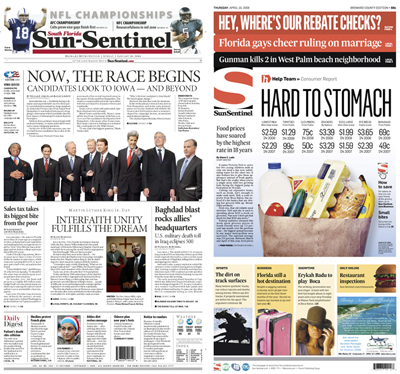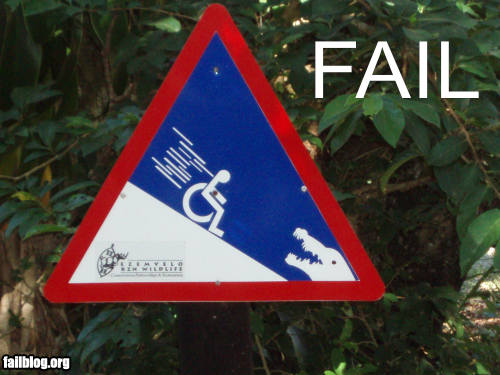Chicago Tribune Editor Gerry Kern sent a memo to staffers last week that challenges some shibboleths of journalism and appears to advocate for giving readers more entertainment at the expense of traditional community affairs.
The message reads like a mission statement. “We clearly are moving toward a 24/7 online business that also publishes in print once a day,” Kern says. While acknowledging the value of traditional fare like public service and investigative reporting, he also stresses the need to delight and entertain.
The nut graph is about halfway down, where Kerns relates that “One of the most revealing insights from recent research is how little excitement some people feel about their daily encounter with us. Many of our regular readers regard us like the electric company or water utility. Yes, everyone wants electricity and water and it’s a pain to do without them. But your soul just isn’t stirred by the sight of working faucet or wall socket.
“Without an engaged audience that finds value in what we offer, we cannot succeed. Journalism is not an abstraction that exists apart from the audience. It must deliver what the audience needs and wants.”
This sounds like a not-too-subtle message that Tribune staff need to take themselves a little less seriously and listen to their readers a little more closely. If that means giving them record reviews and Sudoku puzzles, so be it. The Tribune is about to debut a new design along the lines of its Tribune Co. brethren. If their lead is any indication, you’ll see a lot more color and a little less gravity.
The St. Louis Post-Dispatch has apparently got the same religion. The paper is upgrading its features sections with more emphasis on local entertainment and leisure destinations while merging its news sections and cutting back on commentary.
Also, the Tribune has a new managing editor with a track record of success addressing young audiences. Jane Hirt was the founding co-editor of Redeye a free tabloid aimed at Chicago commuters that is considered one of the Tribune’s more successful recent ventures.
All this may be too little too late. Fitch Ratings on Friday cut the debt rating of Tribune Co. to “CCC” and said default is a “real possibility.” The assessment comes just a week after Tribune CEO Sam Zell said the company had paid down $807 million of borrowing to meet its obligations for the rest of the year. Fitch isn’t very positive, though. The firm believes lenders can expect to get between 31 and 50 cents per dollar of investment.
Too Much Time Spent on “Time Spent”
Editor & Publisher has its regular exclusive report on the amount of time people spend reading newspaper sites. At first blush, the numbers look bad. “Nearly half of the top 30 newspaper sites, ranked by total number of unique users, fell year-over-year,” E&P says. “Fourteen dropped slightly or significantly.”
E&P has been reporting the Nielsen numbers dutifully since Nielsen said it would rely on “time spent” as the most important attribute of newspaper website stickiness a year ago, but a review of some historical numbers shows that this metric has its limitations. Look at the examples below, taken from previous E&P accounts.
|
May ‘07 |
July ‘07 |
May ‘08 |
July ‘08 |
|
| New York Times |
29:36 |
27:21 |
28:52 |
32:03 |
| Wall Street Journal |
14:46 |
12:17 |
8:27 |
18:28 |
| USA Today |
12:39 |
11:48 |
13:00 |
16:17 |
| Philly.com |
10:11 |
6:59 |
8:03 |
5:07 |
| Houston Chronicle |
25:44 |
14:20 |
21:43 |
25:21 |
| Star-Tribune |
36:36 |
22:36 |
27:18 |
36:39 |
| AVERAGE |
21:35 |
15:54 |
17:54 |
22:19 |
While these numbers aren’t necessarily indicative of the overall health of the industry, they demonstrate how unreliable the “time spent” figure can be. Look at The Wall Street Journal, which presumably has enough readers to make its figures consistent. What on earth happened this past May to cause such a drop-off in reader interest? And what happened over the next three months to cause a revival?
Similarly, the Houston Chronicle tanked in July, 2007 but recovered spectacularly in the year since. And are readers in Minnesota staying home this summer cruising the Internet instead of driving? How else to explain such a dramatic recovery? We’re sure the people Philly.com would like to know the answer.
Here’s some interesting perspective on the subject.
Miscellany
Media General’s publishing revenue fell nearly 19% in July compared to a year ago as the sour Florida economy continue to eat away at its business. Classified advertising revenue plunged 32.5% with real estate falling an incredible 47%. Online revenue was up a scant 5.7%,
The Milwaukee Journal Sentinel laid off 22 employees to reach its goal of 130 total job cuts after a voluntary buyout program failed to achieve the magic number.
Valleywag digs up some old screenshots in a trip down memory lane as it tells of “5 ways the newspapers botched the Web.” Reading the account, you get the sense that there were some smart people who saw the opportunities in online publishing as early as 1983 but cluelessness about how people would use the Web combined with a compulsion to protect their print franchises scuttled the early innovations. It’s a depressing account of opportunities lost.
Your obedient editor will be on vacation for a few days and posting less frequently, to the relief of newspaper executives everywhere.

 If you’ve ever taken a “money shot,” you’ll appreciate
If you’ve ever taken a “money shot,” you’ll appreciate 



